A well-presented PNC for a pair of centenaries
Obverse
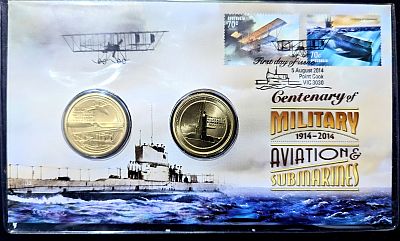
When we think of military aircraft, and of submarines, actively engaged in a war, most of us don’t go back past WWII. This PNC reminds us that both types of craft were active right back to the beginning of WWI.
Fittingly, the PNC features two coins and two stamps. One of each for the centenary of the first military flight, at Point Cook, Victoria, in 1914. And one of each for Australia’s first submarine. While there are images of each on the coins, the stamps and the PNC itself, I do quite like how each is different. There are up to four views of the subject (on the coin, the stamp, the cancellation mark and the main part of the PNC itself). Some PNCs fall into the trap of re-using the same image. In this case, the image of the plane on the envelope and the cancellation mark are quite similar, but otherwise, it is really well done.
Reverse
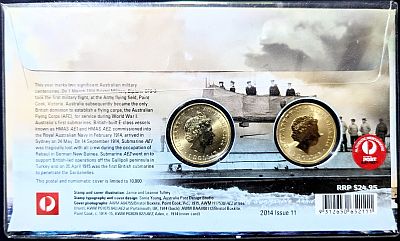
The text on the reverse of the PNC reads: “This year marks two significant Australian military centenaries. On 1 March 1914 Bristol Military Biplane CFS-3 took the first military flight, at the Army flying field, Point Cook, Victoria. Australia subsequently became the only British dominion to establish a flying corps, the Australian Flying Corps (AFC), for service during World War I. Australia’s first submarines, British-built E-class vessels known as HMAS AE1 and HMAS AE2, commissioned into the Royal Australian Navy in February 1914, arrived in Sydney on 24 May. On 14 September 1914, Submarine AE1 was tragically lost with all crew during the occupation of Rabaul in German New Guinea. Submarine AE2 went on to support British-led operations off the Gallipoli peninsula in Turkey and on 25 April 1915 was the first British submarine to penetrate the Dardanelles.”
The coins
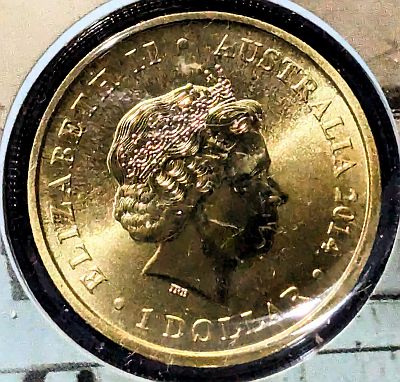
The coins were minted at the Perth Mint. They are slightly larger than circulation coins. Where a circulation dollar is 25mm diameter, Perth’s non-circulating dollar coins are 30.6mm, giving a larger area to present the subject. The value is also listed on the obverse, rather than the reverse. Aside from the subject, the only other details on the obverse are the mintmark “P”, and the initials of the designer, WR for Wade Robinson
The Bristol Boxkite
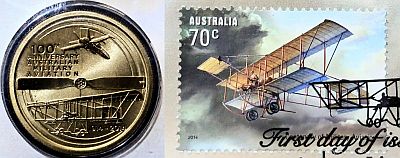
Bristol Aeroplane Company’s first aeronautical venture was the Zodiac, built under licence from Société Zodiac although it was hugely unsuccessful due to insufficient power and poor wing design. Taking what they had learnt from both the experience and the Zodiac design, Bristol created the Boxkite, a highly successful design, which first flew in 1910. Planes were exported to Russia, Australia, New Zealand and India, with production reaching two per week. In total, seventy-eight Boxkites were built.
Three Boxkites were used in the film ‘Those Magnificent Men in Their Flying Machines’.
In 2014, a replica of Australia’s first military Boxkite, CFS-3, recreated the original first flight from Point Cook, with demonstrations by modern F/A-18 Hornet, pictured on the coin.
E-Class Submarines
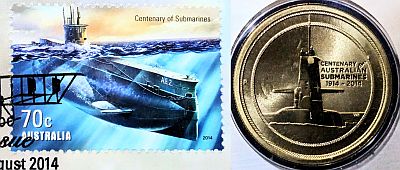
The first submersible vehicle was built back in 1620, by Cornelius Drebbel, for King James I. Over the next few centuries, various designs were developed and built in Europe and the United States of America. Both sides used submarines in the American Civil War in the 1860s. By 1900, in response to the French rapidly building their own submarine fleet, the first modern British submarine, the Holland class, was built in 1901. Refining the design through classes A, B, C and D, by 1911, the E-Class was born. Fifty-six of these diesel submarines were used throughout WWI by the UK. Two more were built for the Royal Australian Navy, AE-1 and AE-2. These travelled the 30,000-mile journey under their own power.
I picked this one up at a coin and stamp fair. I don’t get to these very often, so it was a great chance to chat to other collectors. What was the last event you went to? Did you pick up anything new? Let us know!


Leave a Reply